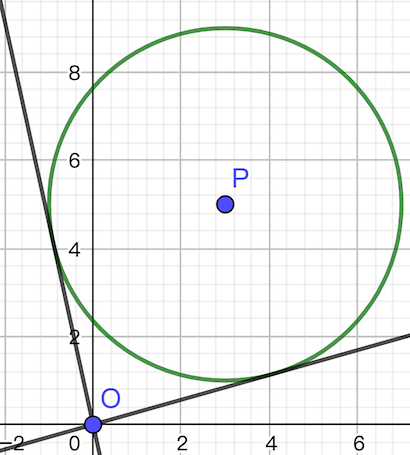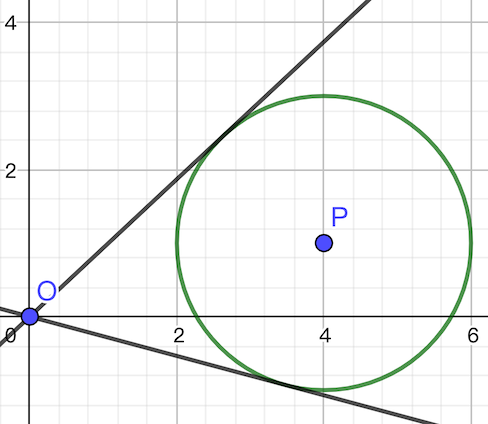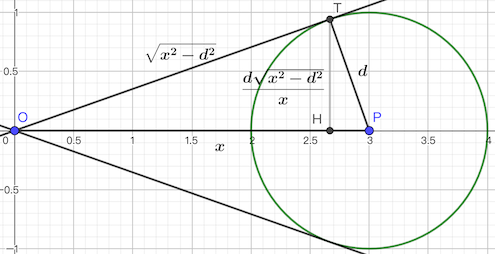题目中出现了至多和最小等字眼,因此很有可能需要使用二分答案。
怎么进行二分呢?我们对 $d$ 进行二分并检验当前 $d$ 值是否符合题意。不难发现,如果一个点到原点的距离不超过 $d$,那么这个点一定符合(所有正比例函数都经过原点)。因此我们只需考虑 $x^2+y^2 \gt d^2$ 的点。
由于到一个点距离不超过 $d$ 的集合就是以该点为圆心,$d$ 为半径的圆内,因此我们只需要求出该圆过原点的两条切线的斜率即可。显然在这两条直线 $y=Lx$ 和 $y=Rx$ 之间(不一定是斜率之间)的所有直线都是符合题意的:

我们只需要找到这 $n$ 个点对应的 $L,R$ 值,将这些点的 $[L,R]$ 抽象成 $n$ 条线段,就可以把问题转化成用最少的点覆盖所有线段的经典贪心问题,并以最少的点数是否小于等于 $k$ 作为二分答案的判断条件。
那么最关键的就是如何求解每个点的 $L,R$。这里有三种方法:
Solution 1 二分套二分
为什么题目要提供点和直线的距离公式呢?实际上,根据之前插图的演示,不难发现直线与点的距离满足一定的单调性。我们可以利用这个性质再一次二分,得到 $L,R$ 的值。
对于斜率等于 $+\infty$ 的情形,我们可以直接在二分前进行处理,例如将其修改成一个足够大的数。
该做法的时间复杂度为 $\mathcal O(n \log x \log x+n \log n \log x)$($x$ 为二分区间大小):
1
2
3
4
5
6
7
8
9
10
11
12
13
14
15
16
17
18
19
20
21
22
23
24
25
26
27
28
29
30
31
32
33
34
35
36
37
38
39
40
41
42
43
44
45
46
47
48
49
50
51
52
53
54
55
56
57
58
59
60
61
62
63
64
65
66
67
68
69
70
71
72
73
74
75
76
77
78
79
80
81
82
83
84
85
86
87
| #include<bits/stdc++.h>
using namespace std;
int n,k;
long double l,r=100000,ans;
struct point
{
long double x,y;
}p[25001];
struct interval
{
long double L,R;
bool operator<(const interval &x)const
{
return R<x.R;
}
}a[25001];
bool check_dis(int x,int y,long double k,long double d)
{
long double dis=fabs(y-k*x)/sqrt(k*k+1);
return dis<=d;
}
interval get(point p,long double d)
{
if(!p.x)return (interval){-p.y/d,p.y/d};
interval ans;
long double l=0,r=p.y/p.x;
while(l<=r)
{
long double mid=(l+r)*0.5;
if(check_dis(p.x,p.y,mid,d))
{
r=mid-0.00000001;
ans.L=mid;
}
else l=mid+0.00000001;
}
l=p.y/p.x,r=100000;
while(l<=r)
{
long double mid=(l+r)*0.5;
if(check_dis(p.x,p.y,mid,d))
{
l=mid+0.00000001;
ans.R=mid;
}
else r=mid-0.00000001;
}
return ans;
}
bool check(long double d)
{
int cnt=0;
for(int i=1;i<=n;++i)
{
if(sqrt(p[i].x*p[i].x+p[i].y*p[i].y)<=d)continue;
a[++cnt]=get(p[i],d);
}
sort(a+1,a+cnt+1);
int tot=0;
long double tmp=0;
for(int i=1;i<=cnt;++i)
{
if(tmp<=a[i].L)
{
tmp=a[i].R;
if(++tot>k)return false;
}
}
return true;
}
int main()
{
scanf("%d%d",&n,&k);
for(int i=1;i<=n;++i)scanf("%Lf%Lf",&p[i].x,&p[i].y);
while(l<=r)
{
long double mid=(l+r)*0.5;
if(check(mid))
{
r=mid-0.0001;
ans=mid;
}
else l=mid+0.0001;
}
printf("%.2Lf",ans);
return 0;
}
|
Solution 2 二分+导角
我们可以通过角和斜率之间的转化求解。
考虑下图的情形(两条直线斜率都非负):

我们可以用反正切函数求出 $PO$ 与 $x$ 轴正方向的夹角 $\alpha$,用反正弦函数求出 $\beta=\angle TOP$。由于两条切线与 $OP$ 之间的夹角相等,因此两条切线与 $x$ 轴正半轴的夹角为 $\alpha ± \beta$。
我们还需考虑下面两种情形:


这种情形下切线斜率一正一负,而这此时直接把负的当左端点、正的当右端点显然是错误的(有一个跨 $0$ 的过程)。又因为题中没有负坐标,因此只需要保留正斜率。那么:
- 在第一种情形中,符合题意的所有斜率的最小值为其中的正斜率,最大值为 $+\infty$。
- 在第二种情形中,最小值为 $0$,最大值为其中的正斜率。
考虑当前的点属于哪一种情形:
- 当切点位于第二象限时(此时 $\alpha+\beta \gt 90^\circ$),属于第一种。
- 当切点位于第四象限时(此时 $\alpha+\beta \lt 90^\circ$),属于第二种。
那么,为什么二分套二分的方法不需要对此进行考虑呢?这是因为,我们可以在求解 $L,R$ 时将二分下界设为 $0$,这样就避免了需要讨论负斜率的情况。
该做法的时间复杂度为 $\mathcal O(n \log x+n \log n)$:
1
2
3
4
5
6
7
8
9
10
11
12
13
14
15
16
17
18
19
20
21
22
23
24
25
26
27
28
29
30
31
32
33
34
35
36
37
38
39
40
41
42
43
44
45
46
47
48
49
50
51
52
53
54
55
56
57
58
59
60
61
62
63
64
65
66
67
68
69
70
71
| #include<bits/stdc++.h>
using namespace std;
const double rt=acos(-1)*0.5;
int n,k;
long double l,r=100000,ans;
struct point
{
long double x,y;
}p[25001];
struct interval
{
long double L,R;
bool operator<(const interval &x)const
{
return R<x.R;
}
}a[25001];
bool check(long double d)
{
int cnt=0;
for(int i=1;i<=n;++i)
{
long double x=p[i].x,y=p[i].y;
if(x*x+y*y<=d*d)continue;
++cnt;
long double alpha,beta;
alpha=atan(y/x);
if(!x)alpha=rt;
beta=asin(d/sqrt(x*x+y*y));
a[cnt].L=tan(alpha-beta),a[cnt].R=tan(alpha+beta);
if(a[cnt].L>a[cnt].R)swap(a[cnt].L,a[cnt].R);
if(a[cnt].L<0)
{
if(alpha+beta>rt)
{
a[cnt].L=a[cnt].R;
a[cnt].R=1e18;
}
else a[cnt].L=0;
}
}
sort(a+1,a+cnt+1);
int tot=0;
long double tmp=0;
for(int i=1;i<=cnt;++i)
{
if(tmp<=a[i].L)
{
tmp=a[i].R;
if(++tot>k)return false;
}
}
return true;
}
int main()
{
scanf("%d%d",&n,&k);
for(int i=1;i<=n;++i)scanf("%Lf%Lf",&p[i].x,&p[i].y);
while(l<=r)
{
long double mid=(l+r)*0.5;
if(check(mid))
{
r=mid-0.0001;
ans=mid;
}
else l=mid+0.0001;
}
printf("%.2Lf",ans);
return 0;
}
|
Solution 3 二分+导边
借助之前的示意图:

不妨设 $T$ 的坐标为 $(a,b)$,则 $OT$ 的斜率为 $\dfrac{b}{a}$,$TP$ 的斜率为 $-\dfrac{a}{b}$。把 $P(x,y)$ 和 $T(a,b)$ 代入得 $\dfrac{b-y}{a-x}=-\dfrac{a}{b}$。化简得 $a^2+b^2=ax+by$。
又因为 $TP=d$,因此有 $(x-a)^2+(y-b)^2=d^2$。化简得 $a^2+b^2-2ax-2by=d^2-x^2-y^2$。
由于 $x,y,d$ 为常数,因此可设 $c=d^2-x^2-y^2$。
因此
$$\begin{cases}
a^2+b^2=ax+by & (1) \cr
a^2+b^2-2ax-2by=c & (2) \cr
\end{cases}$$
把 $(1)$ 代入 $(2)$ 得
$$ax+by=-c$$
因此我们可以将 $b$ 用 $a$ 进行表示(仅在 $y \neq 0$ 时成立):
$$b=\dfrac{-c-ax}{y}$$
再代回 $(1)$ 得:
$$a^2+\dfrac{(c+ax)^2}{y^2}=-c$$
$$a^2y^2+c^2+2acx+a^2x^2+cy^2=0$$
$$(x^2+y^2)a^2+2cxa+c^2+cy^2=0$$
$$a_{1,2}=\dfrac{-2cx±\sqrt{4c^2x^2-4(x^2+y^2)(c^2+cy^2)}}{2(x^2+y^2)}$$
$$=\dfrac{-cx±\sqrt{c^2x^2-(x^2+y^2)(c^2+cy^2)}}{x^2+y^2}$$
$$=\dfrac{-cx±\sqrt{-cx^2y^2-y^2c^2-cy^4}}{x^2+y^2}$$
$$=\dfrac{-cx±y\sqrt{-c(x^2+y^2+c)}}{x^2+y^2}$$
最后求出 $b_{1,2}$ 即可得到两条直线的斜率。
特判 $y=0$ 的情形:

此时 $OP=x$,$TP=d$,$OT=\sqrt{x^2-d^2}$。
作 $TH \perp OP$ 于 $H$,则 $\sin \angle TOH=\dfrac{TP}{OP}=\dfrac{TH}{OT}$。因此 $\dfrac{d}{x}=\dfrac{TH}{\sqrt{x^2-d^2}}$,即 $TH=\dfrac{d\sqrt{x^2-d^2}}{x}$。然后再在 $\triangle OTH$ 中用一次勾股定理即可求出 $OH$。最后斜率即为 $\dfrac{TH}{OH}$。
由于 $y=0$,因此较下方的切线的斜率必然为负。之前提到了本题无需考虑负斜率,因此取斜率的最小值为 $0$,最大值为 $\dfrac{TH}{OH}$ 即可。
$x=0$ 的情形不需单独考虑,因为其斜率的范围显然为 $[-\dfrac{y}{d},\dfrac{y}{d}]$,适用于一般情况。
与导角的方法类似,我们仍需考虑这两种情形:


考虑每个点属于哪一种情形:
- 当负斜率的切点位于 $y$ 轴上方时,第一种情形成立。
- 当负斜率的切点位于 $y$ 轴下方时,第二种情形成立。
相比于导角的做法,该做法时间复杂度仍为 $\mathcal O(n \log x+n \log n)$,但不涉及反三角函数的使用,因此常数较小:
1
2
3
4
5
6
7
8
9
10
11
12
13
14
15
16
17
18
19
20
21
22
23
24
25
26
27
28
29
30
31
32
33
34
35
36
37
38
39
40
41
42
43
44
45
46
47
48
49
50
51
52
53
54
55
56
57
58
59
60
61
62
63
64
65
66
67
68
69
70
71
72
73
74
75
76
77
78
79
80
81
82
83
84
85
86
| #include<bits/stdc++.h>
using namespace std;
int n,k;
long double l,r=100000,ans;
struct point
{
long double x,y;
}p[25001];
struct interval
{
long double L,R;
bool operator<(const interval &x)const
{
return R<x.R;
}
}a[25001];
bool check(long double d)
{
int cnt=0;
for(int i=1;i<=n;++i)
{
long double x=p[i].x,y=p[i].y;
if(x*x+y*y<=d*d)continue;
++cnt;
if(!y)
{
a[cnt].L=0;
long double b1=d*sqrt(x*x-d*d)/x;
long double a1=sqrt(x*x-d*d-b1*b1);
a[cnt].R=b1/a1;
}
else
{
long double c=d*d-x*x-y*y,delta=-c*(x*x+y*y+c);
long double a1=(-c*x+y*sqrt(delta))/(x*x+y*y);
long double a2=(-c*x-y*sqrt(delta))/(x*x+y*y);
long double b1=(-c-a1*x)/y,b2=(-c-a2*x)/y;
a[cnt].L=b1/a1,a[cnt].R=b2/a2;
if(a[cnt].L>a[cnt].R)
{
swap(a[cnt].L,a[cnt].R);
swap(a1,a2);
swap(b1,b2);
}
if(a[cnt].L<0)
{
if(b1>0)
{
a[cnt].L=a[cnt].R;
a[cnt].R=1e18;
}
else a[cnt].L=0;
}
}
}
sort(a+1,a+cnt+1);
int tot=0;
long double tmp=0;
for(int i=1;i<=cnt;++i)
{
if(tmp<=a[i].L)
{
tmp=a[i].R;
if(++tot>k)return false;
}
}
return true;
}
int main()
{
scanf("%d%d",&n,&k);
for(int i=1;i<=n;++i)scanf("%Lf%Lf",&p[i].x,&p[i].y);
while(l<=r)
{
long double mid=(l+r)*0.5;
if(check(mid))
{
r=mid-0.0001;
ans=mid;
}
else l=mid+0.0001;
}
printf("%.2Lf",ans);
return 0;
}
|







